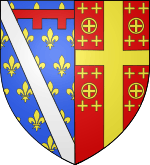Robert, Prince of Taranto

Robert II of Taranto (1319 or early winter 1326 – 10 September 1364[1]), of the Angevin family, Prince of Taranto (1332–1346), King of Albania (1332–1364), Prince of Achaea (1333–1346), Titular Emperor of Constantinople (as Robert II, 1343/1346-1364).
He was the oldest surviving son of Prince Philip I of Taranto and Empress Catherine II of Valois.[1] His paternal grandparents were King Charles II of Naples and Maria of Hungary. His maternal grandparents were Count Charles of Valois and his second wife, Empress Catherine I of Courtenay.
In 1332, as a result of an exchange with his uncle John of Gravina, Robert became Prince of Achaea.[1] Because of his youth, authority was effectively exercised by his mother Catherine II of Valois until her death in 1346. At that point Robert inherited the throne of the Latin Empire, and was recognized as emperor by the Latin states of Greece. His actual power, such as it was, remained based upon his authority as prince of Achaea. In Naples, on 9 September 1347 he married Marie of Bourbon, the daughter of Louis I, Duke of Bourbon Constable of Cyprus,[2] but the marriage was childless. When he died on 10 October 1364, his widow attempted to keep the principality for herself and her son from her previous marriage. However, Robert's younger brother Philip II of Taranto succeeded as the legitimate heir. He died in Naples and was buried there.[3]
Ancestry
| Ancestors of Robert, Prince of Taranto | |||||||||||||||||||||||||||||||||||||||||||||||||||||||||||||||||||||||||||||||||||||||||||||||||||||||||||||||||||||||||||||||||||||||||||||||||||||||||||||||||||||||||||||||||||||||||||||||||||||||||||||||||||||||||||||||||||||||||||||||||||||||||||||||||||||||||||||||||||||||||||||||||||||||||||||||||||||||||||||||||||||||||||||||||||||||||||||||||||||||||||||||||||||||||||||||||||||||||||||||||||||||||||||||||||||||||||||||||||||||||||||||||||||||||||||||||||||||||||||||||||||||||||||||||||||||
|---|---|---|---|---|---|---|---|---|---|---|---|---|---|---|---|---|---|---|---|---|---|---|---|---|---|---|---|---|---|---|---|---|---|---|---|---|---|---|---|---|---|---|---|---|---|---|---|---|---|---|---|---|---|---|---|---|---|---|---|---|---|---|---|---|---|---|---|---|---|---|---|---|---|---|---|---|---|---|---|---|---|---|---|---|---|---|---|---|---|---|---|---|---|---|---|---|---|---|---|---|---|---|---|---|---|---|---|---|---|---|---|---|---|---|---|---|---|---|---|---|---|---|---|---|---|---|---|---|---|---|---|---|---|---|---|---|---|---|---|---|---|---|---|---|---|---|---|---|---|---|---|---|---|---|---|---|---|---|---|---|---|---|---|---|---|---|---|---|---|---|---|---|---|---|---|---|---|---|---|---|---|---|---|---|---|---|---|---|---|---|---|---|---|---|---|---|---|---|---|---|---|---|---|---|---|---|---|---|---|---|---|---|---|---|---|---|---|---|---|---|---|---|---|---|---|---|---|---|---|---|---|---|---|---|---|---|---|---|---|---|---|---|---|---|---|---|---|---|---|---|---|---|---|---|---|---|---|---|---|---|---|---|---|---|---|---|---|---|---|---|---|---|---|---|---|---|---|---|---|---|---|---|---|---|---|---|---|---|---|---|---|---|---|---|---|---|---|---|---|---|---|---|---|---|---|---|---|---|---|---|---|---|---|---|---|---|---|---|---|---|---|---|---|---|---|---|---|---|---|---|---|---|---|---|---|---|---|---|---|---|---|---|---|---|---|---|---|---|---|---|---|---|---|---|---|---|---|---|---|---|---|---|---|---|---|---|---|---|---|---|---|---|---|---|---|---|---|---|---|---|---|---|---|---|---|---|---|---|---|---|---|---|---|---|---|---|---|---|---|---|---|---|---|---|---|---|---|---|---|---|---|---|---|---|---|---|---|---|---|---|---|---|---|---|---|---|---|---|---|---|---|---|---|---|---|---|---|---|---|---|---|---|---|---|---|---|---|---|---|---|---|---|---|---|---|---|---|---|---|---|---|---|---|---|---|---|---|---|---|---|---|---|---|---|---|---|---|---|---|---|---|---|---|---|---|---|---|---|---|---|---|---|---|---|---|---|---|---|---|---|---|---|---|
| |||||||||||||||||||||||||||||||||||||||||||||||||||||||||||||||||||||||||||||||||||||||||||||||||||||||||||||||||||||||||||||||||||||||||||||||||||||||||||||||||||||||||||||||||||||||||||||||||||||||||||||||||||||||||||||||||||||||||||||||||||||||||||||||||||||||||||||||||||||||||||||||||||||||||||||||||||||||||||||||||||||||||||||||||||||||||||||||||||||||||||||||||||||||||||||||||||||||||||||||||||||||||||||||||||||||||||||||||||||||||||||||||||||||||||||||||||||||||||||||||||||||||||||||||||||||
Notes
- 1 2 3 Peter Lock, The Franks in the Aegean: 1204-1500, (Routledge, 1988), 129.
- ↑ The Morea, 1311-1364, Peter Topping, A History of the Crusades: The Fourteenth and Fifteenth Centuries, Vol. III, ed. Kenneth Meyer Setton, (University of Wisconsin Press, 1975), 132.
- ↑ A History of the Crusades: The Fourteenth and Fifteenth Centuries, Vol. III, 141.
Sources
- Topping, Peter (1975). "The Morea, 1311–1364". In Hazard, Harry W. A History of the Crusades, Volume III: The fourteenth and fifteenth centuries. University of Wisconsin Press. ISBN 0-299-06670-3.
- Bon, Antoine (1969). La Morée franque. Recherches historiques, topographiques et archéologiques sur la principauté d’Achaïe (in French). Paris: De Boccard.
| Robert, Prince of Taranto House of Anjou-Taranto Cadet branch of the Capetian House of Anjou Born: 1319/1326 Died: 10 September 1364 | ||
| Preceded by Philip I of Taranto |
Lord of the Kingdom of Albania 1332 |
Succeeded by John of Gravina as Duke of Durazzo |
| Prince of Taranto 1332–1346 |
Succeeded by Louis of Taranto | |
| Preceded by Catherine of Valois |
— TITULAR — Latin Emperor of Constantinople 1346–1364 |
Succeeded by Philip II of Taranto |
| Preceded by John of Gravina |
Prince of Achaea 1332–1364 | |
| Count Palatine of Cephalonia and Zakynthos 1336–1357 |
Succeeded by Leonardo I Tocco | |